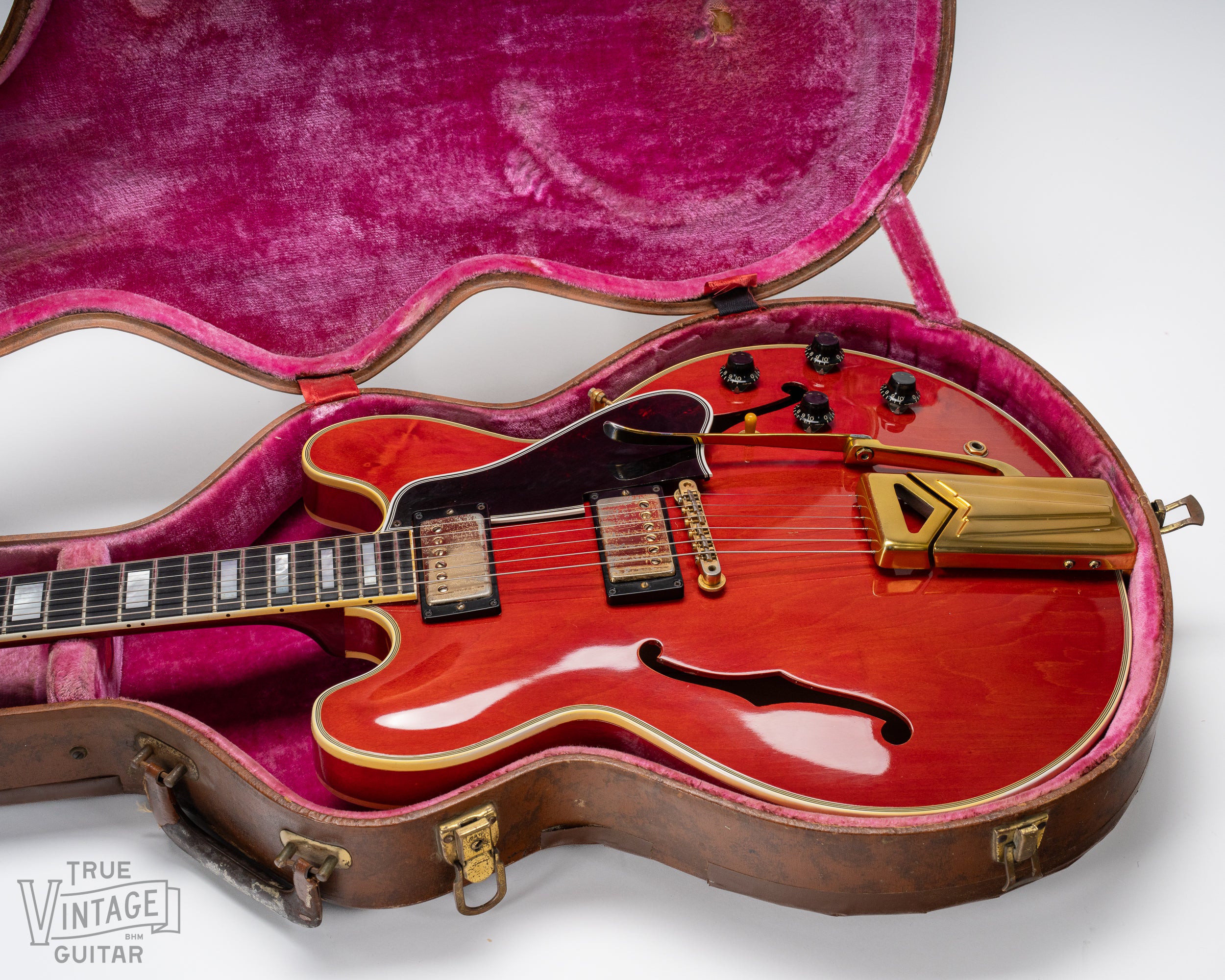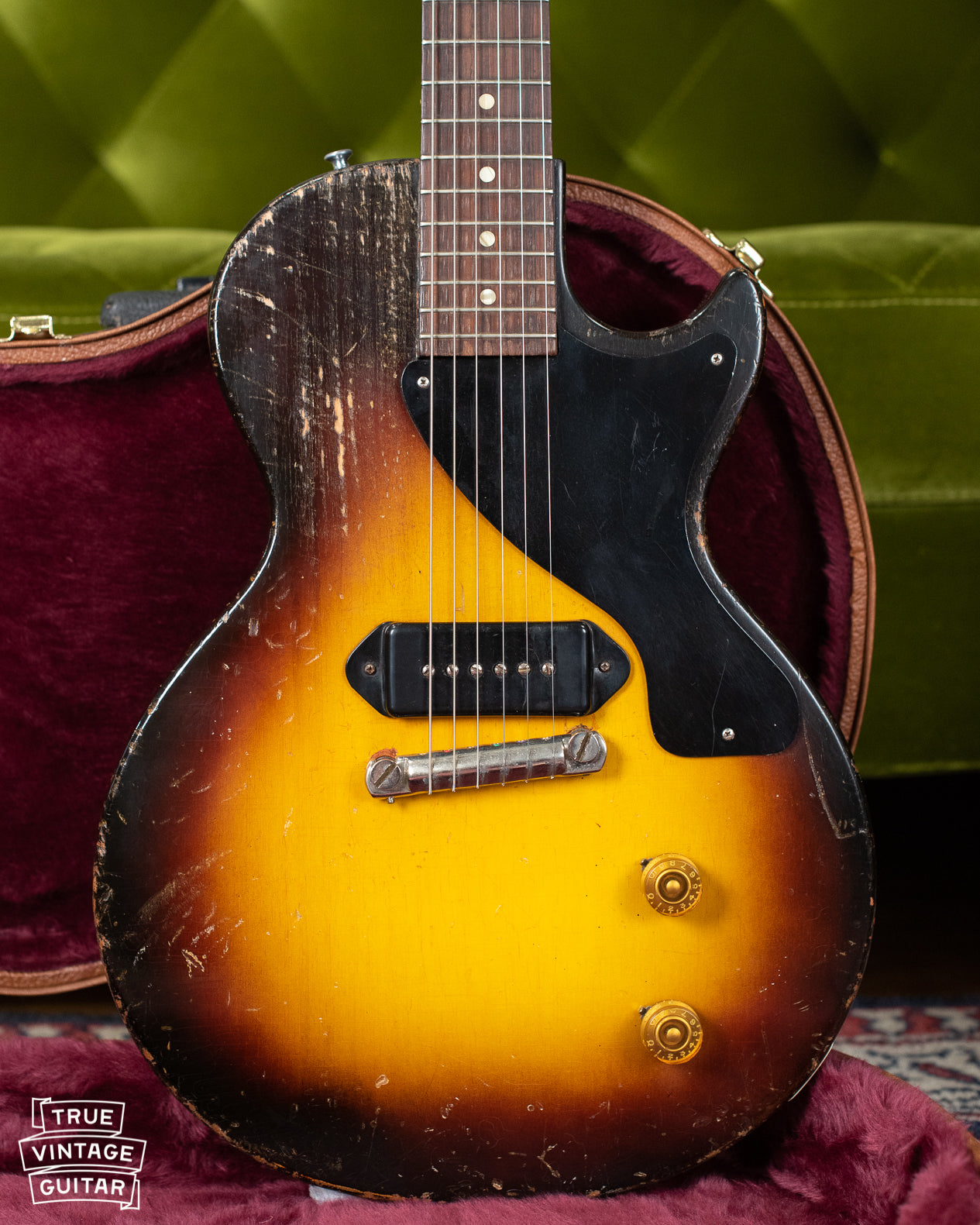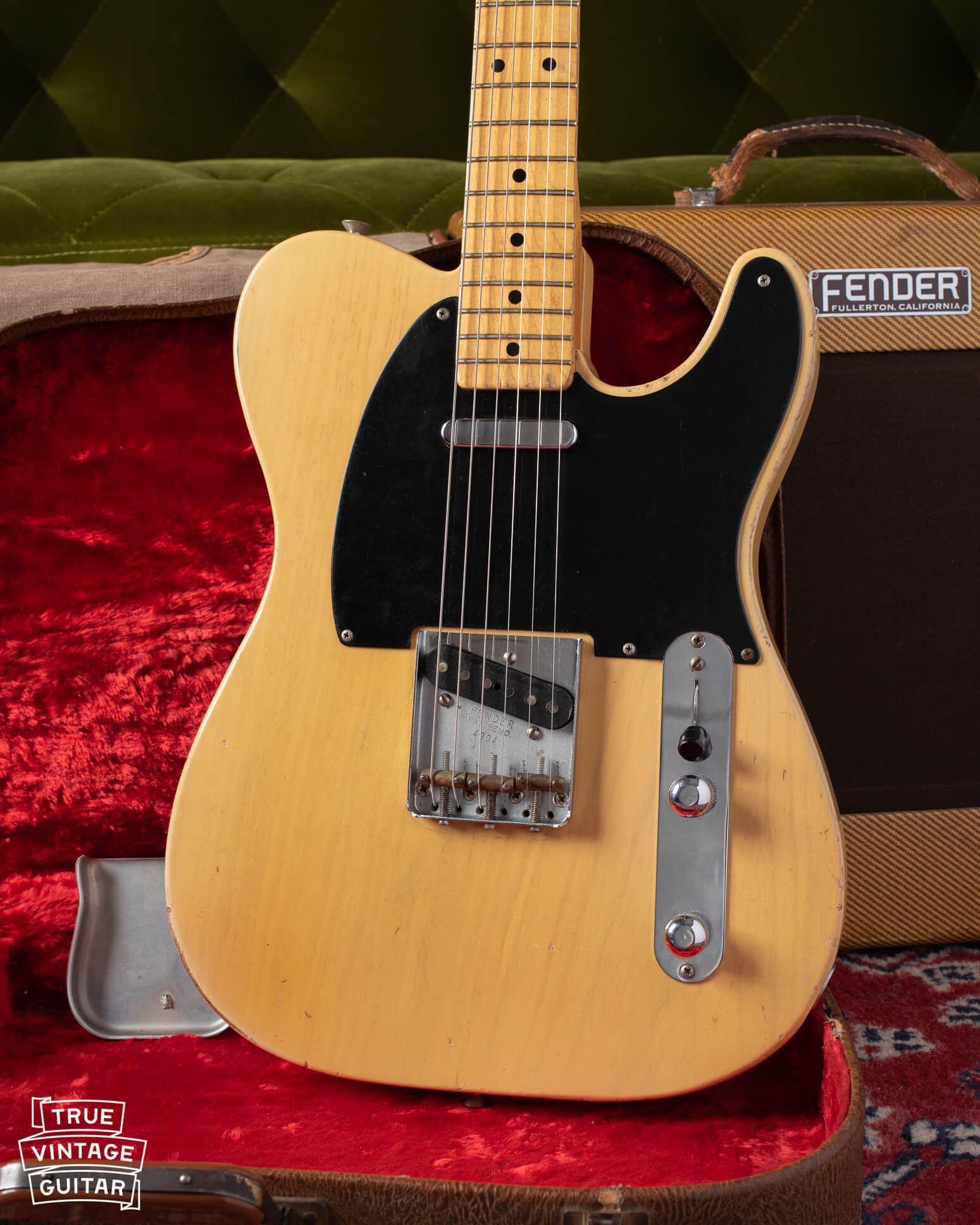Check out this very fine example of the Gibson ES-355 model made in 1959 with a factory installed side pull vibrato! It has just come through our shop and is a spectacular guitar to play. The 1959 Gibson neck profile is truly the perfect happy medium between fat and slim. But wasn't the side pull vibrato introduced in 1961?
We are looking to buy vintage Gibson guitars: Sell a Gibson
Or if you're looking for help dating a Gibson ES-355: ES-335 serial numbers

When I first received pictures of this 1959 ES-355, I was convinced that someone had replaced an original Bigbsby tailpiece with a side pull vibrola in the early 1960s. But as I studied the photographs from the seller, I could see that there weren't any holes from the Bigbsy tailpiece on the top where they should be. I noticed when I held the guitar in person that the gold plating was lacquered over, and that there were no other holes from another tailpiece. What a guitar!
 |
 |
The serial number of the Gibson ES-355 indicated that it shipped in 1959, but I didn't have the exact ship date for the guitar. I knew that Gibson's original drawings of the side pull vibrato existed in 1959 but I wasn't sure when it was actually made. I reached out to a friend of mine at Gibson to see what we could find out about what part of the year this guitar shipped. You can check the scan of the shipment ledger below to see that it shipped on April 22th, 1959.


It’s a 1959 Gibson ES-355T. It’s a mono output, no stereo, no Varitone. A crazy, crazy clean guitar, very nicely preserved. You know it’s a ‘59 as soon as you pick it up. The perfect neck profile, kind of medium-fat, not clubby, not baseball bat-like the early to mid-1950s. It’s great, and the 355s slimmed down a little earlier than the 335s, so you don’t always get that fat neck profile on an early 355.
So, there are three different models in the 3x5 series: 335, 345, and 355. The 335 is always mono 99.9% of the time. There are a couple out there, special order, with stereo. The 345 is 100% of the time stereo. I’ve never seen a single mono 345. The 345 was actually the last one to debut. So, it was 335, 355 early ‘59 or late ‘58, and then later in ‘59, the 345 with stereo Varitone. Then they went back and offered a lot of these 355s with stereo Varitone, so that would be TDSV. But this one is an ES-355T, the mono version of the 355. To me, the king of the lineup of the 3x5 series, it’s all the good stuff of the 335 and all the cool, fancy upgrades like inlays and binding, and that beautiful watermelon cherry red finish.
But if you looked at a lot of ‘59 355s, then you’re looking at this one thinking, “Why does this have a side pull vibrato?” When I was flying out to Davenport, Iowa, to buy this guitar, I fully expected to find some holes underneath this tailpiece from whatever was on there originally. I figured it had a Bigsby, but I didn’t. I’ll tell you more about that in just a bit. But yeah, I’m thrilled to have this one. I flew out to Davenport, Iowa, to meet with the son of its second owner. He got it in the early 1970s, and his family has had it since then. His dad had passed away a decade or so ago, and they held on to it for a long time. He enjoyed playing it sparingly, of course, but then just decided it was time to sell. So, I was happy he gave me a call, and I’m stoked to have it. It’s just such a rare opportunity to get a mono 355, but then just to get the perfect neck profile, ‘59s with the watermelon cherry red, just impossible to find. So, happy to have this one.
It’s completely original inside and out, no modifications, no repairs. The only thing that I found that someone did on this guitar is they had previously removed the covers. So, there was no extra solder on the covers; in fact, they were just kind of chopped through, and the covers were just sitting there. So, we just kind of lightly soldered them back on, just so they’re not falling off or rattling around or anything like that, but they were completely undisturbed underneath. In-phase guitar, great-sounding pickups. You can read the readings on the listing; there’s a link below if you want to check it out. Beautiful-sounding guitar. RGS is going to come play it for us in just a bit. But here’s the deal with the tailpiece: I reached out to my friend at Gibson who has access to the ledgers and said, “Hey man, I just picked up this guitar, and I looked underneath, and there are no extra holes from a Bigsby on this guitar, but it has an A29 series serial number. So, that’s kind of like an early to mid-‘59 serial number. Why, why does this guitar have a side pull vibrato? I would expect that to be, you know, not until 1960 or so. Typically, you see very few with a stop tail, and most of the time, they have the big BB7. So, I fully expected to find extra holes, but there are none.”
Here’s a picture underneath the tailpiece. I took it off, and I laid the tailpiece next to it because I saw three scratches underneath. If you line up the scratches with the underside of this tailpiece, you can see that the scratches are from the bottom of this tailpiece. Then, when I looked at the butt end of the guitar, I could see two sets of holes, but the same pattern. So, this is not a Bigsby pattern. A Bigsby would not have fit in this hole pattern. In fact, what I think they did is they originally mounted this one a little lower on the body, which is how the scratches happened, and then they realized, “Oh, well, you know, we need to mount it a little bit higher on the body, so it’s not contacting the top.” So, that’s what those screws are for, and that’s what those holes are for. You can even see the lower set of holes is like half-plugged, and it has some like buffing compound in there. So, I reached out to my friend at Gibson and said, “Hey, is there any way we can get the shipment ledger on this guitar, because this might be the earliest serial, the lowest serial side pull vibrato guitar I’ve ever seen? So, we probably like to know when this shipped, you know?” So, he reached back out to me. He sent me this page, and here’s the serial number. It is a 29682, and you can see that the date down below it is April 23rd, 1959. So, this one shipped April 22nd, 1959, with this tailpiece. There are no extra holes from another one. So, it couldn’t have had anything else. Couldn’t have had a stop tail because there would have been big holes here. Couldn’t have had a Bigsby because they would have had big, big holes here and a different screw pattern. So, we know it shipped with a side pull vibrato, and likely to be this one because if you look at this one, the plating is a little bit different than you see on most the other kind of Gibson gold-plated parts. So, my friend at Gibson said it’s the earliest side pull vibrato he’s ever seen as well, and that he actually had the scans of the original drawings of the side pull vibrato. I said, “Great, let’s check those out. What’s the date on those drawings? You know, if it’s after April 22nd, and we’ve got to go back to the drawing board and figure something out.” So, he pulls them up. Here’s a scan of the original drawings of the Gibson Deluxe Vibrola, what we call the side pull vibrato, and they’re just dated 1959. So, we don’t have an actual date, but it had to be before April 22nd because this one has no other holes. And I asked him about the plating too. We took the cover off to inspect the structure of the side pull vibrato, just to make sure, you know, is this some kind of reissue or some kind of replacement tailpiece? And it’s not. This is 100% a vintage side pull vibrato, a very special, special piece. And then, if you look at the scan of the side pull vibrato, the original drawings of the side pull vibrato, they’re actually done in the ES-style side pull vibrato, and you can see it’s just a slightly different structure than the side pull vibrato meant for the SG guitars because those are flat. You can see the arm is different. The piece on the end of the tailpiece is thinner on those because they actually mount to the top of the guitar, not the side. So, this may be the first, the earliest known Gibson guitar shipped with the Gibson Deluxe Vibrola or the side pull vibrato. If it’s not, I’d love to see some earlier examples. It’s the earliest one I’ve ever seen. So, if you find some evidence of an earlier one than a 29682, drop me a comment below. I’d love to check it out. What I thought was interesting about the shipment ledger is that it doesn’t mention this tailpiece. So, that seems to be an indication that this may not be the earliest, but who knows?
Anyway, as far as playability, stellar, top-notch, one of the best-playing ESs I’ve ever had. Factory-wide frets are in great shape, no dents, and that sort of thing. Straight neck, just everything is a green light on this guitar. It is so beautiful. Clean everywhere, little bit of scratching here, eh, whatever, some nice belt buckle or something. I didn’t mind it too much. Has a little bit of buffing compound in there or something like that, but not from us, that was there. We just left it. But I was also excited to see, of course."



